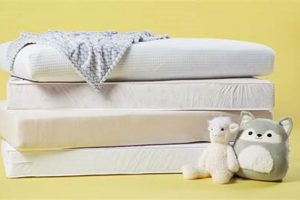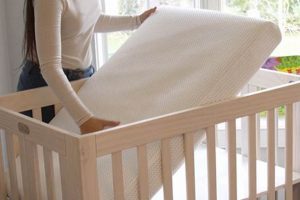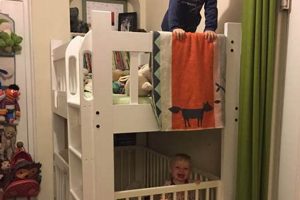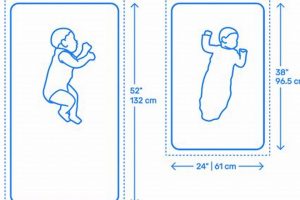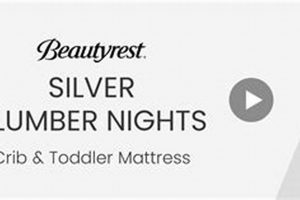A crucial component in infant bedding, this product serves as a protective barrier for the crib mattress. Designed to repel liquids, it prevents absorption of spills, accidents, and other moisture. For instance, urine or spit-up is contained, maintaining the cleanliness and hygiene of the underlying mattress.
The implementation of such a barrier offers several benefits. It extends the lifespan of the crib mattress by preventing staining and degradation from moisture. Furthermore, it contributes to a healthier sleep environment for the infant by mitigating the growth of mold, mildew, and bacteria. Historically, less effective materials were used, leading to potential hygiene concerns that modern waterproof pads are designed to overcome.
The following sections will delve into the materials used in their construction, examine different types available on the market, and provide guidance on selecting a suitable product based on specific needs and priorities. Considerations of safety, durability, and ease of maintenance will also be addressed.
Selection and Usage Tips
This section offers practical advice for selecting and maintaining a high-quality item to safeguard a crib mattress.
Tip 1: Material Assessment: Prioritize materials certified by reputable organizations like OEKO-TEX. These certifications indicate absence of harmful substances. Vinyl, while waterproof, might contain phthalates, which are best avoided. Consider polyurethane laminate (PUL) or thermoplastic polyurethane (TPU) as safer alternatives.
Tip 2: Fit Verification: Precise fit is essential. An ill-fitting pad can bunch up, creating discomfort and a potential safety hazard. Measure the crib mattress dimensions accurately and select a product that corresponds. Avoid pads that are too loose or too tight.
Tip 3: Breathability Consideration: Waterproofing can sometimes compromise breathability. Look for options that claim to be breathable to allow for air circulation, which can help regulate the infant’s body temperature and reduce the risk of overheating. This feature is especially important in warmer climates.
Tip 4: Washing Instructions Review: Before purchase, examine the care instructions. A pad that is machine washable and dryer-safe simplifies maintenance. Frequent washing is essential for hygiene; therefore, ease of cleaning is a significant factor.
Tip 5: Waterproof Testing: Once acquired, conduct a small-scale water test before first use. Pour a small amount of water onto the surface to confirm its waterproof properties. Ensure the liquid does not seep through to the underside.
Tip 6: Backup Provision: It is advisable to have a backup pad available. This ensures that a clean pad is always accessible, particularly when the soiled one is being washed or dried. Having multiple pads streamlines the process of changing bedding after accidents.
Tip 7: Durability Evaluation: Read reviews and assess the product’s durability based on user experiences. Look for indicators of resistance to tearing, cracking, and peeling after repeated washing cycles. A more durable product offers better long-term value.
These tips offer practical guidance for procuring and utilizing such protective bedding effectively.
The next section will discuss common misconceptions related to the product and provide clarifications based on expert recommendations.
1. Waterproof Barrier
A crucial element defining any functional bedding protector is the waterproof barrier. It directly relates to the bedding protector’s ability to shield a crib mattress from liquids and associated damage. The primary purpose is to prevent absorption of spills, bodily fluids, or other moisture into the mattress core. Failure of this barrier results in potential staining, odor development, and microbial growth within the mattress, rendering it unsanitary and potentially shortening its lifespan. For example, consistent urine leakage through an ineffective pad can create a breeding ground for bacteria and mold, impacting infant health.
The effectiveness of the barrier is determined by the materials used and the manufacturing process. Polyurethane films, laminated fabrics, and tightly woven materials treated with water-repellent finishes are commonly employed. Quality control during manufacturing is vital to ensure consistent barrier integrity across the entire surface. The performance of the barrier can also be impacted by washing and drying; therefore, following manufacturer guidelines is essential. Inconsistent care may compromise the protective qualities of the waterproof component.
In summary, the waterproof barrier is indispensable to any crib mattress pad claiming to provide protection. The quality of the materials and adherence to proper care protocols are paramount in ensuring the barrier’s long-term effectiveness. Without a reliable barrier, the pad fails to serve its core function, potentially exposing the infant to unsanitary conditions and diminishing the investment in a quality crib mattress.
2. Non-toxic Materials
The selection of non-toxic materials in a waterproof crib mattress pad directly affects infant health and safety. The prolonged exposure of infants to potentially harmful chemicals found in some bedding materials can lead to adverse health outcomes, including allergic reactions, respiratory issues, and even developmental problems. Therefore, prioritizing non-toxic materials is not merely a preference but a crucial requirement for a quality mattress pad. For instance, volatile organic compounds (VOCs) released from vinyl or chemically treated fabrics can be inhaled by infants, leading to respiratory irritation. A pad manufactured with certified organic cotton and food-grade polyethylene avoids such risks.
The practical significance of understanding the material composition lies in informed decision-making during purchase. Parents and caregivers should actively seek out products with certifications such as OEKO-TEX Standard 100, which verifies the absence of harmful substances exceeding established limits. The use of polyurethane lamination or TPU (thermoplastic polyurethane) as waterproofing layers offers a safer alternative to PVC-based products. Transparency from manufacturers regarding material sourcing and testing procedures further empowers consumers to make choices aligned with health-conscious values.
In conclusion, the utilization of non-toxic materials is an essential element defining the suitability of a waterproof crib mattress pad. The connection between material safety and infant well-being is undeniable. While waterproof functionality remains a primary requirement, it should never come at the expense of exposing the infant to potentially harmful chemicals. Continuous research and stringent material standards are necessary to ensure that the protection offered by such a pad does not inadvertently compromise the child’s health.
3. Breathable Fabric
Breathable fabric, when integrated into a waterproof crib mattress pad, directly impacts the infant’s sleep environment and overall well-being. The purpose of a waterproof layer is to prevent liquid penetration, while breathable fabric mitigates the potential for heat buildup and moisture retention against the infant’s skin. The absence of breathability can lead to increased body temperature, sweating, and subsequent discomfort. For instance, a non-breathable, waterproof layer may trap heat, contributing to an elevated risk of overheating, a concern particularly relevant for infants unable to regulate their body temperature effectively. The causal relationship underscores the importance of balanced functionality.
The application of breathable fabrics, such as specialized polyester blends or cotton with specific weave patterns, promotes air circulation. This allows moisture vapor to escape, reducing humidity and maintaining a more stable and comfortable sleep temperature. The result is reduced discomfort for the infant, potentially leading to improved sleep quality. The practical significance lies in the informed selection of products labeled as “breathable,” often substantiated by third-party certifications. These certifications often indicate adherence to breathability standards tested under controlled laboratory conditions. Furthermore, material composition plays a role. Natural fibers, when treated appropriately for water resistance, can offer a degree of breathability absent in some synthetic alternatives.
The challenge lies in balancing waterproofing and breathability, as inherent characteristics of waterproof materials can impede airflow. Manufacturers employ various techniques, including micro-perforations or membrane technologies, to address this challenge. The ideal product achieves a compromise that maximizes protection without compromising breathability to a degree that affects infant comfort. In summary, breathable fabric is a key feature differentiating a basic waterproof pad from a superior product that actively contributes to a safer and more comfortable sleep environment. Understanding this connection facilitates informed purchasing decisions and supports infant well-being.
4. Secure Fit
The attribute of secure fit is paramount in the context of a waterproof crib mattress pad, extending beyond mere convenience to encompass critical aspects of infant safety and product functionality.
- Reduced Suffocation Risk
A poorly fitted pad can bunch, wrinkle, or slip, creating loose fabric that poses a suffocation hazard for infants. Secure fit ensures the pad remains taut and smooth, minimizing the risk of entanglement or obstruction of the infant’s airway. Real-world examples involve improperly sized sheets or pads that become dislodged during sleep, leading to dangerous situations. A snug, properly sized pad eliminates this hazard.
- Elimination of Gaps
Insecure fit often results in gaps between the pad and the mattress edges. These gaps present opportunities for liquids to bypass the pad, negating its waterproof function. For instance, if urine leaks through a gap, it contaminates the mattress despite the presence of a pad. A secure fit, ideally achieved with elasticized edges, seals the perimeter, preventing leakage and maintaining hygiene.
- Prevention of Dislodgement
An improperly secured pad can be easily dislodged by an active infant. This not only exposes the mattress to potential soiling but also creates an uneven sleep surface that could cause discomfort. For example, a pad that shifts during the night requires constant readjustment and may disrupt the infant’s sleep. A secure fit ensures the pad stays in place, providing a consistent and comfortable sleeping area.
- Enhanced Pad Longevity
A secure fit contributes to the pad’s overall durability. When a pad shifts or bunches, it is subject to increased stress and friction, potentially leading to premature wear and tear. Conversely, a pad that remains securely in place experiences less stress, extending its lifespan and preserving its waterproof properties over time. The physical integrity is maintained longer compared to pads that frequently move.
These facets underscore the integral role of secure fit in maximizing the safety and functionality of a waterproof crib mattress pad. The ability of a pad to effectively protect the mattress and provide a safe sleep environment is directly contingent upon its capacity to remain securely in place throughout its use.
5. Easy Cleaning
The attribute of easy cleaning is intrinsically linked to the value proposition of a waterproof crib mattress pad. This connection arises from the frequency of accidents involving infants, including spills, spit-up, and diaper leaks. The primary function of the pad is to protect the mattress; therefore, the ability to quickly and efficiently remove contaminants from the pad itself is paramount. Without this ease of cleaning, the pad becomes a potential source of bacteria and unpleasant odors, negating its intended purpose of maintaining a sanitary sleep environment. Consider the scenario where a diaper leak occurs during the night; a pad requiring extensive cleaning procedures undermines the goal of swiftly restoring a clean and hygienic sleeping surface.
Practical application translates to design and material considerations. The best waterproof crib mattress pads utilize materials that resist staining and are amenable to machine washing and drying. Complex cleaning protocols involving specialized detergents or hand-washing are counterproductive, as they discourage frequent cleaning, increasing the risk of bacterial growth. A pad that can be easily wiped down for minor spills and thoroughly cleaned in a washing machine for larger incidents contributes significantly to maintaining hygiene. Furthermore, quick-drying capabilities are beneficial, reducing the time the crib is out of commission. Material choices, such as avoiding overly textured surfaces that trap debris, further enhance the ease of cleaning.
In summation, easy cleaning is not merely a desirable feature, but an essential component of a high-quality waterproof crib mattress pad. The interrelation between protective functionality and simple maintenance determines the pad’s overall efficacy in providing a clean and hygienic sleep environment. While waterproofing is crucial, the value is diminished if the pad itself becomes difficult to clean and maintain. Therefore, careful consideration of cleaning protocols and material properties is vital when selecting a protective bedding solution.
6. Durable Construction
Durable construction is a foundational element in evaluating a waterproof crib mattress pad. The longevity and effectiveness of the protective barrier directly depend on the robustness of its materials and assembly, impacting overall value and lifespan.
- Material Integrity
The constituent materials must withstand repeated use and cleaning cycles without degradation. High-quality fabrics, such as tightly woven cotton blends or durable polyester, resist tearing and abrasion. The waterproof layer, often composed of polyurethane laminate (PUL) or thermoplastic polyurethane (TPU), should maintain its integrity over time, preventing cracking or peeling. Substandard materials lead to premature failure, compromising the waterproof function.
- Seam Strength
Seams represent potential weak points in any textile product. A durable crib mattress pad features reinforced seams that resist unraveling or splitting, especially along the edges and corners. Robust stitching techniques, such as double-needle stitching or overlocking, contribute to seam strength, preventing liquid penetration and extending the pad’s usable life. Weak seams compromise the waterproof barrier and overall structural integrity.
- Edge Binding Durability
Edge binding protects the perimeter of the pad from fraying and adds to its overall structural stability. Durable edge binding is constructed from robust materials and securely attached to the pad, preventing unraveling or detachment. Damaged edge binding exposes the inner layers of the pad, compromising its waterproof properties and reducing its lifespan. Quality binding reinforces the pad’s perimeter and resists wear and tear.
- Resistance to Washing and Drying
A durable crib mattress pad withstands repeated washing and drying cycles without shrinking, losing its shape, or compromising its waterproof qualities. High-quality materials and construction techniques ensure the pad retains its original dimensions and protective properties after laundering. Susceptibility to shrinking or damage during cleaning renders the pad ineffective and necessitates frequent replacement.
These considerations regarding durable construction are integral to the overall assessment of a waterproof crib mattress pad. The selection of high-quality materials, coupled with robust assembly techniques, contributes directly to the product’s longevity and its ability to consistently protect the crib mattress from spills and accidents.
7. Hypoallergenic Properties
The presence of hypoallergenic properties in a crib mattress pad is directly linked to the infant’s respiratory health and skin sensitivity. A primary function of a waterproof crib mattress pad is to create a barrier against liquids and spills, but the materials used to achieve this function can inadvertently trigger allergic reactions in susceptible individuals. Dust mites, mold, and pet dander are common allergens that can accumulate in bedding, exacerbating conditions such as asthma and eczema. A pad lacking hypoallergenic characteristics may trap these allergens, leading to increased exposure for the infant. A certified hypoallergenic pad, conversely, utilizes materials designed to resist allergen accumulation and minimize the risk of triggering allergic responses. For instance, a pad made with tightly woven fibers and antimicrobial treatments can effectively inhibit dust mite colonization and mold growth.
The practical significance of selecting a crib mattress pad with hypoallergenic properties lies in proactive allergy management. Infants are particularly vulnerable to allergic sensitivities due to their developing immune systems. A hypoallergenic pad reduces exposure to potential irritants, decreasing the likelihood of allergic reactions that can disrupt sleep and compromise respiratory health. Moreover, the materials used in hypoallergenic pads are often free from common chemical allergens, such as formaldehyde and phthalates, further minimizing the risk of adverse reactions. Certifications from organizations like the Asthma and Allergy Foundation of America (AAFA) provide assurance that a product has met specific standards for allergen control. Parents and caregivers are able to make informed choices that prioritize the infant’s well-being. Choosing a product with these features is a beneficial step towards providing a healthier sleep environment for the infant.
In summary, hypoallergenic properties are not merely an optional feature but a crucial consideration when selecting a waterproof crib mattress pad. The interplay between allergen exposure and infant health underscores the importance of proactively mitigating potential triggers within the sleep environment. While waterproofing remains a primary function, the incorporation of hypoallergenic materials and design elements contributes significantly to creating a safer and more comfortable sleeping space for the infant. The ongoing development of innovative materials and manufacturing techniques facilitates the production of crib mattress pads that effectively balance waterproof functionality with hypoallergenic properties, ultimately promoting infant health and well-being.
Frequently Asked Questions
This section addresses common inquiries and concerns regarding protective bedding for crib mattresses, offering clarity and guidance.
Question 1: Are all waterproof crib mattress pads equally effective?
No. Effectiveness varies significantly based on materials, construction, and design. Factors influencing performance include the waterproof membrane type, seam integrity, and overall fit. Products lacking robust construction or utilizing inferior materials offer diminished protection.
Question 2: How often should a waterproof crib mattress pad be washed?
Wash frequency depends on usage and soiling. Minor spills necessitate immediate spot cleaning. Routine washing every one to two weeks is recommended. Prompt laundering after any significant soiling is essential to maintain hygiene.
Question 3: Can a waterproof crib mattress pad eliminate the need for a crib mattress?
No. A protective pad is designed to safeguard the mattress, not replace it. The mattress provides essential support and cushioning for the infant. The pad serves as a supplementary layer of protection against liquids and allergens.
Question 4: Do all waterproof crib mattress pads contain harmful chemicals?
Not necessarily. Many products utilize non-toxic materials certified by organizations such as OEKO-TEX. However, some pads may contain PVC or phthalates. Careful examination of the product label and material composition is crucial to avoid potentially harmful chemicals.
Question 5: Does a waterproof crib mattress pad impact mattress breathability?
Some pads may reduce breathability. However, products incorporating breathable fabrics or membrane technologies mitigate this issue. Prioritizing pads with breathable properties is advisable to promote airflow and regulate infant body temperature.
Question 6: Are thicker waterproof crib mattress pads always better?
Thickness does not automatically equate to superior performance. While a thicker pad may offer enhanced cushioning, the quality of materials and construction are more critical determinants of effectiveness. A well-constructed, thinner pad may outperform a poorly made, thicker alternative.
In summary, the selection and maintenance of a protective bedding component for crib mattresses require careful consideration of materials, construction, and usage patterns.
The next section will address common misconceptions associated with the protective bedding.
Conclusion
This exploration of the best waterproof crib mattress pad underscores its essential role in infant care. Reliable protection against moisture, selection of safe materials, and ease of maintenance are pivotal considerations. The analysis illuminates the interconnectedness of these features and their impact on hygiene and the child’s well-being. Practical guidance offered here is intended for use when choosing such products based on specific priorities.
Investment in a high-quality product offers protection and contributes to a healthier sleep environment for infants. Continued research and development in material science hold the promise of further enhancing the safety, durability, and overall performance of the best waterproof crib mattress pads, ensuring a better future for infant health and hygiene. Manufacturers, experts, and consumers must continue to improve these products.


![Best Crib Mattress: Newton vs Naturepedic [2024] Organic & Natural Mattress Buyer’s Guide: Non-Toxic Sleep Solutions Best Crib Mattress: Newton vs Naturepedic [2024] | Organic & Natural Mattress Buyer’s Guide: Non-Toxic Sleep Solutions](https://mattressworldpa.com/wp-content/uploads/2025/07/th-1292-300x200.jpg)
